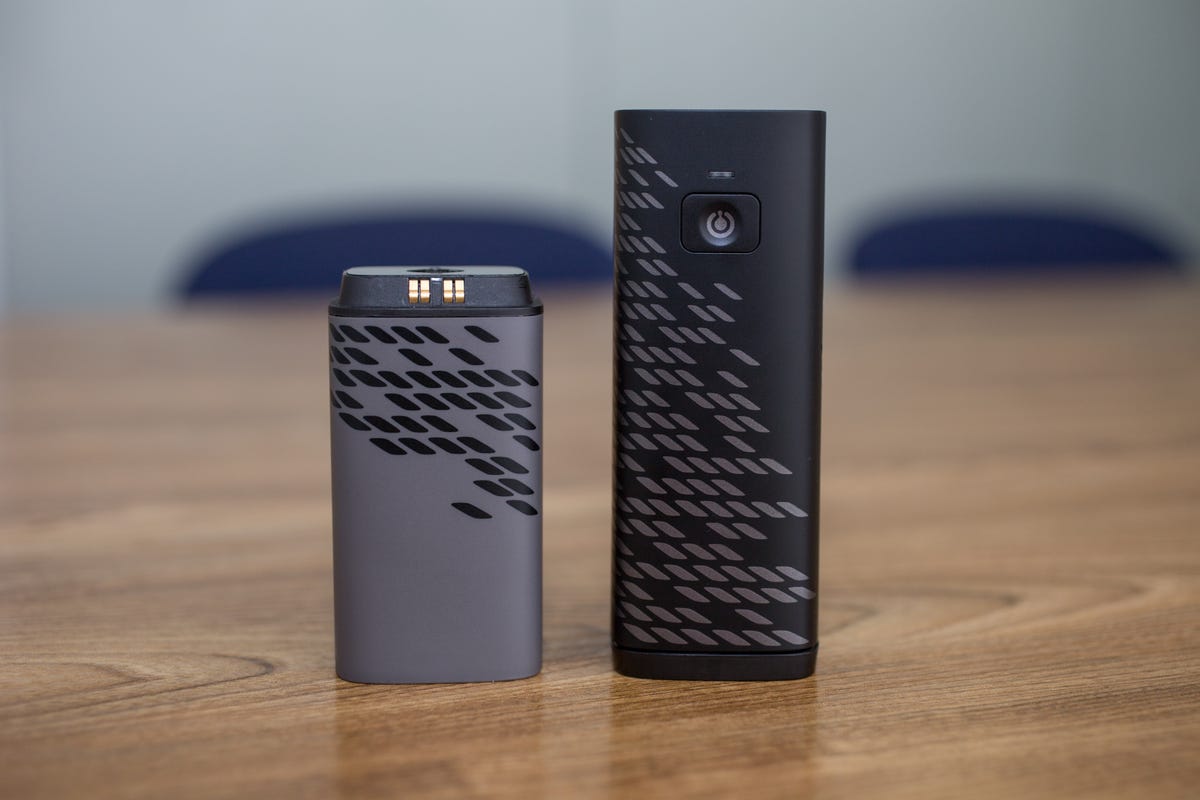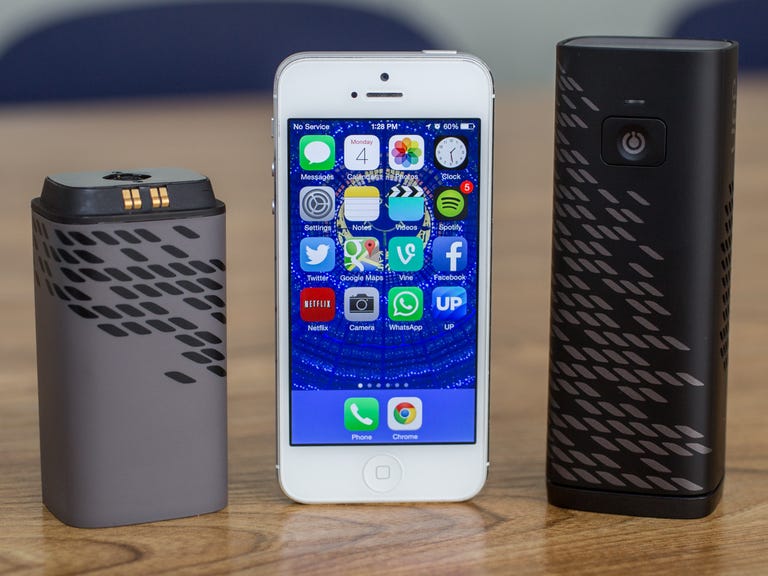 Why You Can Trust CNET
Why You Can Trust CNET Upp fuel cell charger review: Futuristic fuel cell charger still no match for old-fashioned batteries
The Upp fuel cell charger keeps your phone ticking when there are no plug sockets nearby, with eco-friendly hydrogen and a very cool app.
Clean energy could change the world, which is why lots of people are excited about fuel cell technology. The Upp fuel cell charger is one of the first consumer fuel cell products, converting hydrogen into electricity without any harmful by-products to charge your phone when you're far from home.
The Good
The Bad
The Bottom Line
The Upp is a USB charger into which you plug a cartridge containing hydrogen, forming a Proton Exchange Membrane fuel cell. It works by creating a chemical reaction that produces electricity. The only by-products are heat and water vapour.
Unlike battery packs, Upp won't degrade over time, so the hydrogen cartridge can be refilled by the manufacturer and you can continue using the charger indefinitely. The 5W, 5V charger charges as fast as the mains and is well-suited for phones, although less so for power-hungry tablets such as the iPad .
Upp claims its hydrogen fuel cells are much better for the environment than current chargers. It's worth noting that like any gadget, Upp contains plastic and metal and so has a cost to its production and disposal. But fuel cells have for a while been touted as the next big power source, especially for cars, potentially replacing or at least reducing reliance on fossil fuels. That sounds great, which is why it's a shame that the Upp has several problems.
The charger is available now from Upp's website for £149 in the UK. It's not yet available in the US, but the company has said it will cost $200 from the retailer Brookstone, and presumably the same from its own site.
How it works
The Upp charger couldn't be simpler to use: just take the cap off the end of the charger and connect the hydrogen fuel cell. They attach magnetically so the fuel cell snaps satisfyingly into place.

At the end of the charger is a familiar USB socket. Plug your phone or any USB-charging device into the cable as normal, turn the charger on and away you go.
Simple it may be -- portable it is not. The Upp is touted as a power source when you don't have access to the mains, whether you're in a campsite in Cornwall or deep in the wilds of the developing world. But you need a few hydrogen cartridges with you if you're spending any time off the grid, and they ain't light.
The charger weighs 235g (8.3 ounces) and each spare cartridge 385g (13.6 ounces), for a combined weight of 620g (1.4 pounds). The whole unit is about the size and weight of a medium-sized torch, one of the big ones powered by a batch of C batteries.
As it charges, the fuel cell vents water vapour every few minutes. Unfortunately, that makes a clearly audible "click-click" noise. It's not loud enough to scare anyone, but if you've got your phone charging next to you, the noise gets annoying fast. If you were camping, for example, it might keep you awake at night.
Replacing cartridges
Not only are the cartridges far from light, they ain't cheap either: you get one with the charger but after that a spare costs £35, and swapping empty for full costs £10 a pop. That converts to $59 and $17 respectively, but expect it to be a little cheaper in the US.
Swapping for a full cartridge limits where you can use the charger. The included app and Upp's website show you where you can get more hydrogen cartridges on a map, with dozens of locations in the UK and US. Currently they're all listed as "coming soon", however, and tend to be clustered in highly populated areas. In the US, many of the locations will be at branches of Brookstone.
If you're planning to take the Upp on a plane, you'll need to check with your airline. The UK's Civil Aviation Authority says that you can take fuel cell devices on board a plane in your hand luggage, but you can only take two spare cartridges. Fuel cells are technically classified as "dangerous goods", so you would be best checking before you get to the airport.
Even if the Upp itself was lighter, the limited access to refills is a problem, with huge swathes of the UK and US without any locations. As much as I would love to advocate a potentially environmentally sound solution, in purely practical terms it simply isn't any match for buying a smaller, lighter, battery-powered charger and stocking up on batteries that can be bought anywhere. Just make sure you buy rechargeable batteries and recycle them.
If the Upp charged your device many times, of course, the size and availability of cartridges would be less of an issue. Sadly, at this early stage of the technology that isn't yet the case.
How many charges do you get?
Upp says one cartridge charges a phone five times. That means one cartridge should last around five days of normal phone use. I tested that by charging a selection of phones, all of which were completely dead to start with. I plugged them in one after the other, and found that I couldn't charge any more than three phones from one cartridge.
The first cartridge charged an HTC One X , an HTC Desire 610 and a Huawei Ascend P2 before it was empty. The second cartridge charged a Sony Xperia Z2 and a BlackBerry Z30 before it was exhausted.
Only two or three charges out of a single cartridge costing £10 or $17 is pretty disappointing. And it also means you have to stock up on lots of expensive, heavy cartridges, or make more trips to exchange them.
That said, you can squeeze a bit more juice out of a cartridge using the best thing about the Upp: the very clever app that comes with it.
Clever app
The Upp app is by far the best thing about it -- at this early stage in fuel-cell technology, anyway -- and I'd happily use the app on my phone even without the Upp charger.
The Upp app, which is available for iPhone and Android, gives you fine control over the charging process. You can plug the charger into any phone and start charging, or install the app on the phone in question to see how much hydrogen is left in the cartridge and how much charge is in the battery. It also tells you how much time you have left to call people, play music, browse the Web or watch videos.
You can set the app to charge the phone to any percentage level you want -- so if you're running short on hydrogen or time you could opt to just top up the battery slightly instead of fully charging it.
As it approaches the specified level, the app slows the process so as not to waste hydrogen on keeping the phone topped off. This saves the small amount of energy constantly expended on running apps in the background, or keeping the Wi-Fi on.
The charger knows when the phone is fully charged and stops charging when the battery is full -- especially useful if, like most of us, you leave your phone charging overnight.
Conclusion
Fuel-cell technology is something to keep an eye on: it's efficient, it's green, and it may be the future. But at £150 for the charger, £35 for a cartridge and another £10 for every few charges, the Upp charger is simply too expensive -- and too heavy -- to compete with chargers that run on cheap, easy-to-find, lightweight batteries. The one positive is the excellent app.


